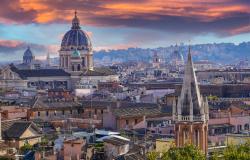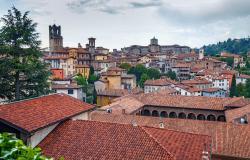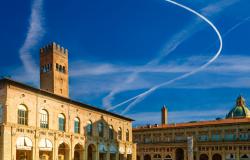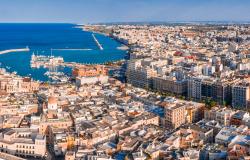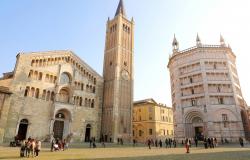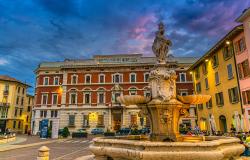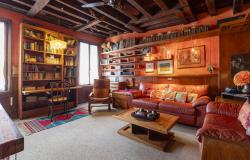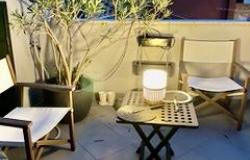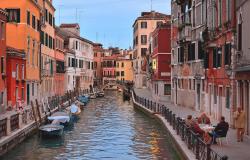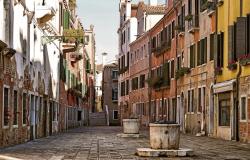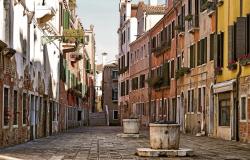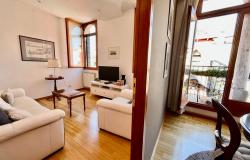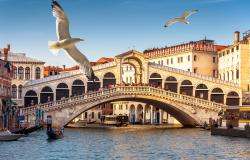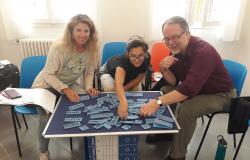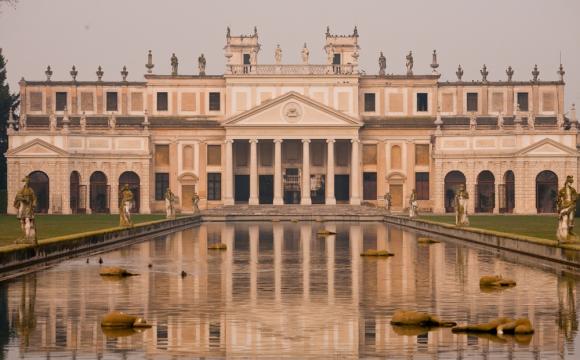The morning mists still swirled over the lagoon as the ferry approached Venice. At first all we could see were wooden channel markers (bricole) as they drifted in and out of view. The water lapped softly against the boat, and the cry of gulls fills the air.
Arriving by vaporetto (or waterbus) from the airport is the most magical of ways to enter in Venice. Against a backdrop of “campanili” and “torri”, the ferrymen shout out greetings while helping tourists and locals alike across the gangway. Subject only to the tides, the vaporetto takes its time as it crisscrosses the islands of the Venetian lagoon. Then comes the stop of San Marco and the world erupts into divine chaos.
The stop of San Marco is along the Riva degli Schiavoni, a sweeping promenade named after those Dalmatian traders (the Schiavonia) who once used this stretch for mooring their boats. Dozens of gondolas float side by side, waiting for business; tourists from all over the world mingle with school children and those blessed to live and work in Venice. The promenade offers spectacular views across the Venetian Lagoon to the island of San Giorgio Maggiore. Amongst the jumble of medieval buildings hawkers cheerfully tout postcards and toy gondoliers, t-shirts and gelati of all flavours (for a day in Italy without eating a gelato is a wasted day.)

San Marco's was once the centre of Europe. Our place of abode, the Istituto San Giuseppe, lay merely two hundred steps away. Despite luggage in tow, we paused on the Ponte della Paglia to stare at the Bridge of Sighs. How many have stood here, desperate for a final glimpse of a loved one doomed to disappear forever into the infamous dungeons?
Our path lead from the Piazza San Marco under the Torre dell’Orologio, where two huge bronze moors have struck the hour (with variable accuracy) since the fifteenth century. Our first steps took us along the Mercerie, a string of narrow alleys which link San Marco to the Rialto area. Renown for shopping, only the things for sale here have changed down the centuries; not the cobbles, not the buildings, not the throngs of people. Most of the shops are tiny, often with room for only two or three people.
By step forty we’d left the crowds for a world of cobble stones and tiny piazzas. Chairs and tables spilled from the restaurants and cafes, and the smell of coffee and pizza filled the air. Restaurants lined the streets, most specializing in seafood. Our first slice of pizza proved thin-crust and perfect.
A turn of a corner – few are the streets in Venice which run in a straight line – and a limestone bridge arched gracefully over a canal. Our convent lay directly opposite, with a door opening directly onto the water. On cue a gondola glided by, coming to a colourful stop outside our convent to collect passengers.
The Istituto San Giuseppe proves a maze of grand staircases and marble halls. Paintings cover the ceilings and walls – in a room large enough to host a masked ball, a fresco peeked out from under the scaffolding of restoration – and everywhere is bathed in peace. Our room was simple and clean. The windows opened onto a terracotta skyline, with clothes strung on a line between two buildings. Across a flower-strewn courtyard a woman in black was busy in her kitchen, filling the air with delicious aromas. Geraniums hung everywhere in pots. In the distance a campanile tolled away the hours while towering (at a slight angle) over the other buildings. Next morning we woke to the sound of seagulls, followed shortly by the first bells of the day. As is the way all over Italy, each church keeps its own, strict time, and the bells chime a few minutes apart, never quite in unison.

Istituto San Giuseppe - Venezia
One of the delights of Venice is how the city changes with the hours. Of an early morning, the famed four horses of San Marco look down onto a piazza home to pigeons and people downing a quick espresso on their way to work. The Rialto markets are less than ten minutes of cobblestone streets away. As the sun rises, stalls overflow with products from the sea – unrecognisable fish, bags of crabs, slabs of fresh swordfish. Aside from “i frutti di mare”, there are also stalls of fresh meat, chees, bread and fruit. Breakfast comes in the form of delectable cups of fresh berries and peaches. We sat eating near the statue of the Gobbo (The Hunchback), a coffee from a nearby cafe close to hand.
Venice is a city to be explored on foot. Chaotic streets suddenly become deserted alleys. No matter how confusing the winding streets become, there is always a sign pointing either to the Rialto Bridge or to San Marco's – often in a direction which seems counter-intuitive. Most streets wind, many bridges bend, and by late afternoon even space and time seem to curve until reinforced with a double espresso.
By mid-morning, the cafes and restaurants lining the Piazza San Marco are overflowing. Competing string quartets fill the air with waltzes. In seeking the Palazzo Contarini del Bovolo, we left the Piazza San Marco and religiously followed our map, only to emerge back on the other side of the piazza. A second attempt and we were rewarded – but only by following other people who had cameras at the ready, rather than relying on the small signs pasted haphazardly on the buildings. The Palazzo boasts a tower with a curving, external stairway, highlighted in white marble against the terracotta building.

Palazzo Contarini del Bovolo - Venezia
Taking the Number One vaparetto is a perfect way to sit back and watch Venice unfold. It travels slowly from San Marco to the railway station, and with its frequent stops allows plenty of time to watch as grand palaces and forgotten houses float by. Many of the buildings have grand entrances at water level with exquisite Moorish windows on the higher floors.
It is during the evening promenade, however, that the Piazza San Marco truly comes alive. As the evening mist swirls in from the lagoon, pink lamps glisten against the gathering darkness, and sense of carnival fills the air as people fill the square.
The light shimmers with white marble. Venice becomes once more a Medieval mistress, a place of Renaissance allure and Baroque decay, a city of carnival and masques, a city of hidden identity, daring you to come and explore.

